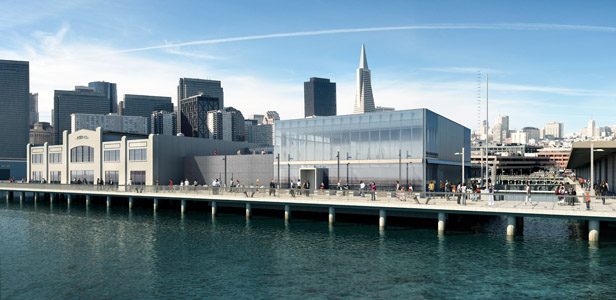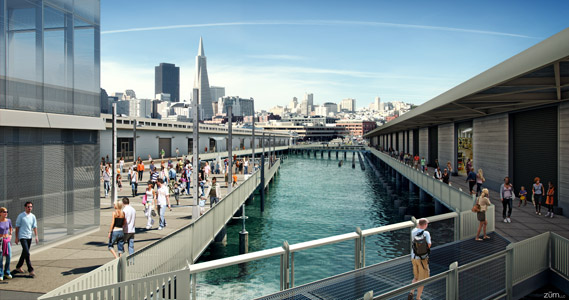Moving to Pier 15 from its current location at the Palace of Fine Arts triples the amount of space at the Exploratorium and doubles the amount of classroom space and meeting space.

Image by ZÛM LLC
By Bill Picture
Published: November, 2012
Moving to Pier 15 from its current location at the Palace of Fine Arts triples the amount of space at the Exploratorium and doubles the amount of classroom space and meeting space. What’s more, its ultramodern new building and over-the-Bay location provide a unique hands-on learning facility that turns the Exploratorium’s new home itself into an educational tool.
The Exploratorium’s executive director, Dr. Dennis M. Bartels, said that the new location—opening next spring—will "profoundly" affect the institution.
"We’ll be focusing a lot more on energy and environmental sciences," he said. "Being in a building that’s LEED (Leadership in Energy and Environmental Design) certified and hangs half over the water help dictate that focus, which we’re excited about. Also, you have to remember that at our current location, we’ve had to shrink Mother Nature down to tabletop size to fit her indoors. At Pier 15, we’ll have acres and acres of outdoor space to play in."
Even greener than green
Large construction projects in San Francisco now have to comply with strict green building codes enacted to minimize a building’s environmental footprint for the duration of its long life—from the time ground is broken on through its years of occupancy. But the Exploratorium’s building committee and design team set an even higher green goal for themselves during the early stage of the planning process.
"LEED Silver was required for this project, but we determined early on that Gold was achievable," said Marc L’Italien, the project’s lead architect and a principal at San Francisco-based design firm EHDD.
But even LEED Gold wasn’t good enough for this bunch of overachievers, who set their sights on reaching net zero energy status—that is, building a building that consumes no energy it can’t generate itself, and produces no carbon emissions.
"It’s a very high bar to reach, but we decided to think beyond LEED, and aspired to become the largest net-zero museum in the United States, if not the world," L’Italien said. "That’s been the overarching goal, and it made other features individual means to an end."
The means to which L’Italien refers go way beyond the usual recycled building materials and energy-efficient accessories now standard through San Francisco building. For starters, L’Italien and his team took advantage of the near-constant temperature of the San Francisco Bay, improving upon centuries-old technology to use the Bay’s water to steady the temperature inside the museum.
"I wish we could take credit for the idea, but the concept of heating and cooling buildings with water goes back to the Romans," said L’Italien.
That said, radiant heating and cooling have never been used in a building as big as the new Exploratorium. The Monterey Bay Aquarium would probably be the next closest, size-wise. "Sometimes it’s better to be the second to try something, and let the first guy work out all the bugs," said Bartels.
Another major feature is the 1.3-megawatt solar power system installed on the Exploratorium’s roof. The nearly 6,000 high-energy solar panels were produced by Richmond-based SunPower, generate 50 percent more energy than conventional solar panels, and will generate 100 percent of the electricity required for operating systems and exhibitions. "They’re the most efficient solar panels on the market," said Bartels. "And we’re really happy that we were able to source them from a local company."
While the building’s most outstanding features—including the maximized use of natural light and 100 percent fresh-air circulation—represent the latest trends in architecture and design, L’Italien points out that many of these trends aren’t new at all.
"They were quite common long ago," he explained. "But we went through a cycle of innovation that brought modern conveniences but also resulted in high energy use. Now, technology has improved so we can do those things better."
Starting at Zero
All involved in the project agree that even though retrofitting the badly-earthquake-damaged pier was no easy task (it required new pilings underneath the pier), no challenge equaled the net zero energy goal. "That singular goal is impacting every part of this project—and the organization as well," said Bartels. "It’s life-changing, because it drives not only technical changes, but behavioral changes as well, right down to the exhibit level."
"It requires starting with a super-energy-efficient design," said L’Italien, "thereby reducing the amount of energy having to be produced. The less predictable aspect of this challenge is the energy required by equipment and occupants, known as ‘plug loads.’"
And rather than hiding the energy efficiency behind the scenes, Bartels and his team intend to incorporate them—you might even say "flaunt" them—into the educational experience afforded to guests.
For instance, the pumps used to draw water from the Bay for heating and cooling the building are enclosed in glass, allowing guests to see the pumps in action. Further, guests will be able to watch the building’s ever-changing energy draw on monitors fed by sensors that pull data from the museum’s various energy systems.
"The museum becomes this living, breathing thing, constantly adjusting itself," said Bartels. "Our program team is already talking about how to translate the numbers from those sensors into information that guests can understand, maybe graphs or something."
The building has another green feature that Bartels said people seem to overlook—the location itself. The Exploratorium’s current location, while gorgeous, is a bit out of the way, making it difficult to get to by public transit and harder still by foot or on bike. Pier 15 is much transit-friendlier and accessible by bus, streetcar and ferry. The Exploratorium is also working with the San Francisco Bicycle Coalition to drive more bike-traffic to the museum.
"It’s funny that nobody’s really talking about how moving the Exploratorium from the foot of the Golden Gate Bridge to Pier 15 will change the way that people get here," Bartels said. "Right now, visitors pretty much all come by car, so just the move itself will be a huge energy-saver. I myself will be taking the ferry a lot more, which I’m really excited about."
For information about the Exploratorium’s new home at Pier 15, visit www.exploratorium.edu/piers.

In an effort to reach a net zero energy status, the new Exploratorium will feature a 1.3-megawatt solar power system installed on the roof including nearly 6,000 high-energy solar panels. Image by ZÛM LLC

Image by ZÛM LLC

